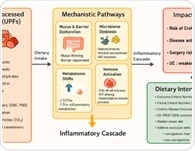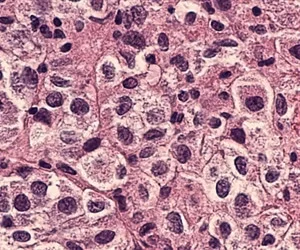
|
|
|
| |

|
|
| |
The latest gastroenterology news from News Medical |
|
|
|
 | | |  Industrial and farm chemicals quietly alter the balance of gut microbes Industrial and farm chemicals quietly alter the balance of gut microbes This study systematically screened over 1,000 agricultural and industrial chemicals and found that many can inhibit human gut bacteria in vitro. Beyond antimicrobial effects, these chemicals act as selective pressures that can reshape microbial competition, tolerance mechanisms, and metabolic pathways. | | | | |  Why the form of vitamin B12 you take may matter more than your intake Why the form of vitamin B12 you take may matter more than your intake This comprehensive review examines vitamin B12 absorption, physiological roles, deficiency states, and dietary sources, with particular attention to differences between natural and synthetic forms. The authors conclude that while all B12 forms raise circulating levels, methylcobalamin may offer advantages in specific clinical contexts, especially where absorption or metabolic conversion is impaired. | |
|
|
|  | | | | |  Settling the creatine safety debate Settling the creatine safety debate Research confirms creatine's safety, highlighting misinformation and low-quality supplements as primary concerns over cancer and kidney health risks. | |  | | | | |  Gut microbe metabolite TMA improves blood sugar by shutting down a key inflammatory switch Gut microbe metabolite TMA improves blood sugar by shutting down a key inflammatory switch Researchers identified trimethylamine (TMA) as a gut microbe–derived metabolite that directly inhibits IRAK4 to reduce metabolic inflammation and improve glycaemic control in high-fat-diet-fed mice. Choline-driven increases in TMA production replicated these benefits, revealing a host–microbe signaling axis with therapeutic potential for obesity-associated insulin resistance. | |  | | | | |  How ultra-processed foods shape Crohn’s disease risk and what dietary strategies can really help How ultra-processed foods shape Crohn’s disease risk and what dietary strategies can really help This narrative review synthesizes evidence showing that higher intake of ultra-processed foods is consistently associated with increased Crohn’s disease risk, with mechanistic pathways implicating emulsifiers, carrageenan, maltodextrin, titanium dioxide, sweeteners and salt. It also highlights that minimally processed dietary strategies, including EEN and CDED, show therapeutic promise, particularly in pediatric Crohn’s disease. | |
|
|
|  | | | Researchers at örebro University in Sweden have made a significant advance in understanding the intestinal condition IBS. | | | | |  Researchers profiled a terminally sterilized probiotic-fermented MFH beverage and identified aporphine alkaloids and flavonoids with favorable predicted ADMET properties. Integrated network pharmacology, molecular docking, and 100-ns MD simulations suggest multi-target engagement of metabolic-inflammatory pathways relevant to obesity and type 2 diabetes. Researchers profiled a terminally sterilized probiotic-fermented MFH beverage and identified aporphine alkaloids and flavonoids with favorable predicted ADMET properties. Integrated network pharmacology, molecular docking, and 100-ns MD simulations suggest multi-target engagement of metabolic-inflammatory pathways relevant to obesity and type 2 diabetes. | | | | |  Serious side effects, including neurotoxicity and intestinal inflammation, that appear weeks or months after patients receive CAR T cell therapy for multiple myeloma share a common immune root cause, are associated with high rates of death unrelated to cancer relapse-primarily infection-and may be avoidable. Serious side effects, including neurotoxicity and intestinal inflammation, that appear weeks or months after patients receive CAR T cell therapy for multiple myeloma share a common immune root cause, are associated with high rates of death unrelated to cancer relapse-primarily infection-and may be avoidable. | | | | |  Human intestinal M cells function as dendritic cell-like antigen-presenting cells, displaying constitutive MHC-II activity and specialized machinery for processing gluten. Their ability to deamidate and present gliadin peptides positions them as key initiators of immune responses relevant to coeliac disease. Human intestinal M cells function as dendritic cell-like antigen-presenting cells, displaying constitutive MHC-II activity and specialized machinery for processing gluten. Their ability to deamidate and present gliadin peptides positions them as key initiators of immune responses relevant to coeliac disease. | | | | |  In adults with stage IIIb–IV chronic kidney disease, the constipation drug lubiprostone did not reduce gut-derived uremic toxins but preserved creatinine-based kidney function over 24 weeks. The benefit was linked to microbiome remodeling, increased polyamine production, and improved mitochondrial function rather than toxin lowering. In adults with stage IIIb–IV chronic kidney disease, the constipation drug lubiprostone did not reduce gut-derived uremic toxins but preserved creatinine-based kidney function over 24 weeks. The benefit was linked to microbiome remodeling, increased polyamine production, and improved mitochondrial function rather than toxin lowering. | | | | |  Children in Guatemala who received a common vaccine that helps prevent pneumonia were less likely to carry antibiotic-resistant bacteria, according to a new study led by Washington State University researchers. Children in Guatemala who received a common vaccine that helps prevent pneumonia were less likely to carry antibiotic-resistant bacteria, according to a new study led by Washington State University researchers. | | | | |  A study led by McMaster University researchers shows that a widely available and inexpensive medication not only prevents potentially serious stomach bleeding in critically ill patients, but also saves hospitals thousands of dollars. A study led by McMaster University researchers shows that a widely available and inexpensive medication not only prevents potentially serious stomach bleeding in critically ill patients, but also saves hospitals thousands of dollars. | | | | | Mass General Brigham is announcing the spinout of AIwithCare, a company founded by researchers from the health system who developed an artificial intelligence (AI) screening tool that significantly outperformed manual screening for determining a patient's eligibility and enrolling them in a clinical trial. | | | | |  Researchers investigate how soybean oil may disrupt fat metabolism to potentially increase the risk of obesity. Researchers investigate how soybean oil may disrupt fat metabolism to potentially increase the risk of obesity. | | | | |  Primary sclerosing cholangitis (PSC) is a chronic, progressive inflammatory disease characterized by fibrosis and bile duct stricturing, which ultimately leads to cirrhosis and liver failure. PSC is strongly associated with both types of inflammatory bowel disease (IBD), namely, ulcerative colitis and Crohn's disease. Primary sclerosing cholangitis (PSC) is a chronic, progressive inflammatory disease characterized by fibrosis and bile duct stricturing, which ultimately leads to cirrhosis and liver failure. PSC is strongly associated with both types of inflammatory bowel disease (IBD), namely, ulcerative colitis and Crohn's disease. | | | | |  The human small intestine absorbs nutrients while protecting us from potentially harmful microbes. One of the cell types that plays a key role in this protection is the microfold cell, or M cell. The human small intestine absorbs nutrients while protecting us from potentially harmful microbes. One of the cell types that plays a key role in this protection is the microfold cell, or M cell. | | | | | Myotonic dystrophy type 1 (DM1) is the most common form of adult-onset muscular dystrophy, affecting about 1 in 8,000 people. While it is well known for causing muscle weakness and stiffness, DM1 also affects other organs, including the brain, heart and gastrointestinal (GI) tract. | | | | |  Ebola (EBOV) and Marburg virus (MARV) are highly lethal viruses that cause severe disease in infected patients by extensively damaging the body. Ebola (EBOV) and Marburg virus (MARV) are highly lethal viruses that cause severe disease in infected patients by extensively damaging the body. | | | | |  In a revelatory Genomic Press Interview published today in Brain Medicine, Dr. Paul Lucassen, full professor at the University of Amsterdam and leader of the Brain Plasticity group, shares his scientific journey that helped transform our understanding of how adult brains adapt to challenge and change. In a revelatory Genomic Press Interview published today in Brain Medicine, Dr. Paul Lucassen, full professor at the University of Amsterdam and leader of the Brain Plasticity group, shares his scientific journey that helped transform our understanding of how adult brains adapt to challenge and change. | | | | |  In a major step towards a precision therapy for Clostridioides difficile (C. diff) infection, researchers at The Hospital for Sick Children (SickKids) have uncovered how the body's bile acids bind to block C. diff's most dangerous toxin. In a major step towards a precision therapy for Clostridioides difficile (C. diff) infection, researchers at The Hospital for Sick Children (SickKids) have uncovered how the body's bile acids bind to block C. diff's most dangerous toxin. | |
|
|
|
|
|
|
|